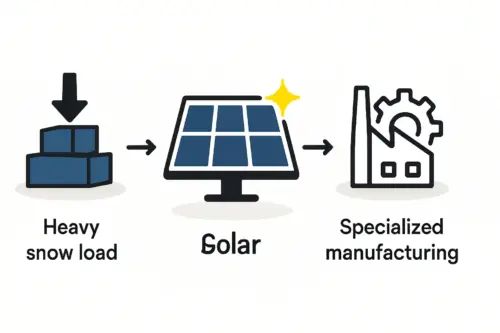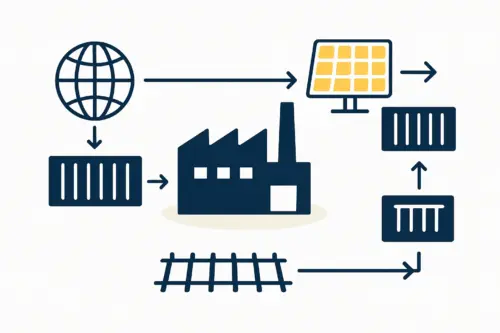Many international business leaders exploring European expansion are surprised to learn that Sweden—a country known for its strong worker protections—has no statutory minimum wage. Yet, its labor market operates with remarkable predictability and stability. This apparent contradiction is resolved by a deeply ingrained system known as the ‘Swedish Model,’ built upon Collective Bargaining Agreements, or Kollektivavtal.
For any entrepreneur planning to establish a manufacturing facility in Sweden, understanding this framework isn’t just an administrative detail; it is fundamental to operational strategy, financial planning, and long-term success. This article explores the practical implications of this model for factory operations, from wage setting to dispute resolution.
The Foundation of Swedish Labor: The ‘Swedish Model’
Sweden’s labor market is unique in that it is largely self-regulated. Rather than government legislation dictating the minutiae of wages, working hours, and benefits, these terms are negotiated between two powerful parties: employers’ federations and trade unions.

The model’s effectiveness stems from extremely high participation rates. Approximately 70% of all employees in Sweden are union members, and nearly 90% work for companies belonging to an employers’ association. This widespread participation gives the negotiated agreements—the Kollektivavtal—near-universal coverage within their respective sectors. For a new manufacturing enterprise, engaging with this system is therefore a practical necessity for smooth operations.
At its core, the model is designed to foster cooperation and long-term stability rather than confrontation. It establishes a clear, mutually accepted ‘rulebook’ that governs the relationship between a company and its workforce.
How Wages Are Determined Without a Minimum Wage Law
The lack of a government-mandated minimum wage does not lead to unpredictable labor costs. Instead, wages are determined through a highly structured, multi-level negotiation process.
The process begins at the industrial sector level, where major unions (like IF Metall for manufacturing) and their employer counterparts negotiate a central agreement. This agreement sets ‘The Mark’ (märket)—a benchmark for wage increases that serves as a guideline for all other sectors across the economy. The Swedish National Mediation Office, a government agency, plays a crucial role in facilitating these talks and ensuring the resulting wage levels are compatible with maintaining low inflation and Sweden’s international competitiveness.
This centralized approach offers significant advantages for business planning. With ‘The Mark’ establishing a predictable percentage for wage growth, companies can forecast their operational costs analysis with a high degree of accuracy several years in advance.
From Central to Local: Applying Agreements in Your Factory
The Kollektivavtal system operates on two main levels, providing both a standardized framework and company-specific flexibility.
Ready to make big Profits?
The solar Industry is Booming
WE HELP NEWCOMERS to the solar industry start their own solar module production line. Customers can make BIG PROFITS by selling modules and finding investors, without wasting money and time on things they don't need!
Central Agreements: Negotiated at the national level for an entire industry (e.g., technology, construction, or manufacturing), these establish minimum standards for wages, general working hours, overtime compensation, insurance, and pension contributions.
Local Agreements: At the factory level, management and local union representatives negotiate a local agreement. This agreement cannot offer terms less favorable than the central one but adapts its provisions to the facility’s specific needs.

For instance, a central agreement might specify the total number of working hours per year, while the local agreement details shift patterns, flexible scheduling for production peaks, or specific break-time arrangements. This two-tiered structure provides a robust national standard while allowing for essential operational adaptability.
Key Provisions in a Typical Manufacturing Kollektivavtal
A collective agreement is a comprehensive document that extends far beyond wages. For a new factory owner, understanding these key components is essential for managing the workforce effectively.
Working Hours and Overtime
While Sweden’s Working Hours Act (Arbetstidslagen) provides a legal baseline of 40 hours per week, nearly all collective agreements contain different provisions. A Kollektivavtal commonly allows for more flexible scheduling, such as averaging working hours over several weeks or months—a critical feature for manufacturing operations that need to align labor with fluctuating production schedules. The agreement also precisely defines the rules and compensation rates for planned and unplanned overtime. Understanding these rules is key to hiring skilled labor for manufacturing and retaining a productive team.
Leave, Pensions, and Insurance
The Kollektivavtal system includes a comprehensive benefits package that forms a significant part of an employee’s total compensation. This typically includes:
- Supplemental Pensions: Contributions to occupational pension schemes (such as ITP plans), which are a cornerstone of the Swedish pension system.
- Enhanced Insurance: Additional coverage for workplace injuries, sickness, and parental leave that often provides benefits well beyond state-provided minimums.
These packages are standardized within the agreement, simplifying administration for the employer while providing attractive benefits for employees.
Dispute Resolution
A fundamental principle of the Swedish model is the ‘peace obligation’ (fredsplikt). As long as a collective agreement is in force, unions and employees are prohibited from initiating industrial action, such as strikes, over any matter covered by the agreement.
Should a disagreement arise over the interpretation or application of the agreement, a clear, multi-step resolution process is in place:
- Local Negotiation: The issue is first discussed between factory management and local union representatives.
- Central Negotiation: If no local solution is found, the matter is escalated to the central employers’ federation and trade union.
- The Labour Court: If central negotiations fail, the dispute is referred to the Swedish Labour Court (Arbetsdomstolen), whose ruling is final.
This structured process ensures that disputes are handled methodically, providing operational continuity and minimizing production disruptions.
The Strategic Advantage for New Manufacturing Operations
While the Kollektivavtal system may seem complex to an investor new to the Swedish market, it offers distinct strategic advantages that foster a stable business environment.
- Predictability: The centralized wage-setting process and clearly defined terms provide a stable foundation for financial forecasting and long-term business planning.
- Stability: The peace obligation and structured dispute resolution process drastically reduce the risk of unforeseen labor disputes and costly production stoppages.
- Efficiency: The system provides a ready-made, comprehensive framework for labor relations, saving a new company considerable time and effort in negotiating employment terms from scratch—a significant benefit when focusing on the core tasks of building a factory in Sweden.
Our experience with J.v.G. turnkey projects in various international markets shows that this degree of labor market stability is a significant asset, one not always present in other regions where labor relations can be more adversarial or less structured.

Frequently Asked Questions (FAQ)
Is it mandatory for a company to sign a collective agreement?
No, it is not legally mandatory. However, if a company in a unionized sector chooses not to, the relevant trade union will likely demand one and may initiate industrial action to achieve it. In practice, the vast majority of companies find it more efficient and stable to join an employers’ association and become part of an existing agreement.
What happens if our company does not have a Kollektivavtal?
Beyond the risk of industrial action, the company would have to negotiate individual contracts with every employee to cover all terms of employment. Furthermore, it would not have access to the collectively bargained insurance and pension packages, which is a significant disadvantage when competing for skilled labor.
Can a local agreement be less favorable than the central one?
No. The central agreement establishes the minimum floor for rights and benefits. The purpose of the local agreement is to adapt the central rules to the workplace, not to undermine them.
How does this model affect hiring and termination?
The Swedish Employment Protection Act (Lagen om anställningsskydd, LAS) provides the legal foundation for employment contracts, notice periods, and grounds for termination. The Kollektivavtal often builds upon this law, providing more detailed procedures, specific notice periods based on seniority, and clear rules for managing redundancies.
Conclusion and Next Steps
The Swedish system of Collective Bargaining Agreements is a mature and highly functional model of labor relations, built on partnership, mutual respect, and a shared interest in a stable and competitive industrial environment. For a new manufacturing investor, embracing this system is the most effective path toward a predictable, stable, and successful operation.
A thorough understanding of these labor dynamics is essential for accurate project planning and financial forecasting. For business professionals beginning this journey, structured educational resources like the e-courses from pvknowhow.com can offer a clear roadmap for navigating these foundational requirements.






